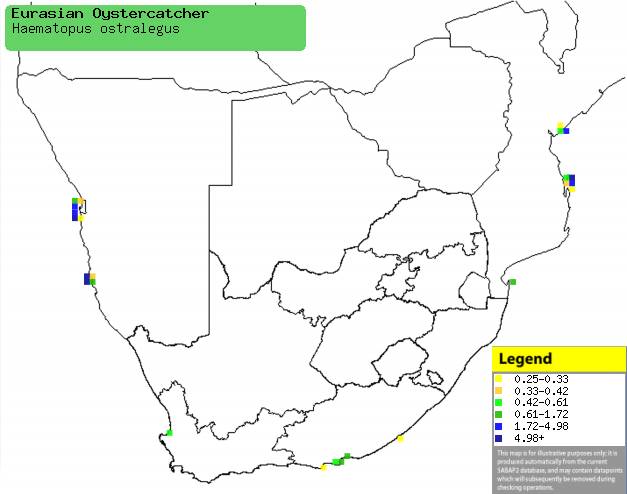|
Haematopus ostralegus (Eurasian
oystercatcher)
Bonttobie [Afrikaans]; Scholekster [Dutch]; Huîtrier
pie [French]; Austernfischer [German]; Ostraceiro-europeu [Portuguese]
Life
> Eukaryotes >
Opisthokonta
> Metazoa (animals) >
Bilateria >
Deuterostomia > Chordata >
Craniata > Vertebrata (vertebrates) > Gnathostomata (jawed
vertebrates) > Teleostomi (teleost fish) > Osteichthyes (bony fish) > Class:
Sarcopterygii (lobe-finned
fish) > Stegocephalia (terrestrial
vertebrates) > Tetrapoda
(four-legged vertebrates) > Reptiliomorpha > Amniota >
Reptilia (reptiles) >
Romeriida > Diapsida > Archosauromorpha > Archosauria >
Dinosauria
(dinosaurs) > Saurischia > Theropoda (bipedal predatory dinosaurs) >
Coelurosauria > Maniraptora > Aves
(birds) >
Order: Charadriiformes
> Family: Haematopodidae
Distribution and habitat
Breeds at Iceland, central and northern Russia and China,
heading south in the non-breeding season to eastern Asia and the coast of
Africa, mainly above 20° North. It is a vagrant to southern Africa, with over 70
records (and counting) spread across the southern coast of South Africa and
coastal central Namibia and Mozambique. It generally prefers sheltered shores
with soft sediment, such as estuaries and lagoons, while largely absent from
rocky areas.
|
 |
|
Distribution of Eurasian oystercatcher in southern Africa,
based on statistical smoothing of the records from first SA Bird Atlas
Project (©
Animal Demography unit, University of
Cape Town; smoothing by Birgit Erni and Francesca Little). Colours range
from dark blue (most common) through to yellow (least common). |
References
-
Hockey PAR, Dean WRJ and Ryan PG 2005. Roberts
- Birds of southern Africa, VIIth ed. The Trustees of the John Voelcker
Bird Book Fund, Cape Town.
|
